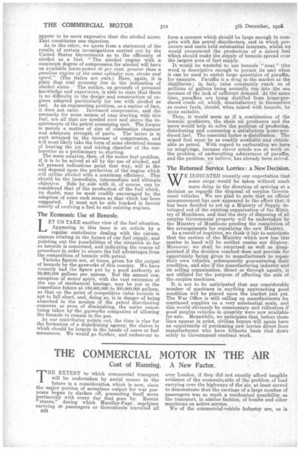THE COMMERCIAL MOTOR IN THE AIR
Page 2

Page 3

If you've noticed an error in this article please click here to report it so we can fix it.
Cost of Running. A New Factor.
THE EXTENT to which commercial transport will be undertaken by aerial means in the future is a consideration which is now, since the major portion of aeroplane output for war purposes began to slacken off, presenting itself more pertipertinently with every day that goes by. Recent nently during which Handley-Page. ma-chines carrying 40 passengers or thereabouts travelled all 1324
over London, if they did not exactly afford tangible evidence of the economie,side of the problem of load carrying over the highways of the air, at least served to demonstrate that the carriage of a large number of passengers was as much a mechanical possibility as the transport, in similar fashion, of bombs and other munitions on active service.
We of the commercial-vehicle industry are, as is
natural, friendlily concerned with the development of this new form of transport. The extent to which its possibilities have now been foreshadowed as the result of four years of intensive study of the problems of aerial navigation, it is unnecessary to labour here ; the fact is self-evident. Aeroplanes of great capacity, of relatively huge bulk and of long sustaining power, equipped with the means to counteract to a considerable extent the disturbing effect of bad weather, have long ago entered into the realm of practical politics. Sufficient has been done in this direction thanks to unlimited national expenditure and to the war-bred necessity of getting the best that could be obtained at all costs, to undertake not only that the carriage of heavy loads at high speeds is practical, but also that the sphere for further investigation and experiment is almost unlimited.
Schooled as we have been since the very disappointing early days of mechanical-transport experiments, we certainly need not be sceptical as to the very considerable future that lies before navigation of the air for other than sporting or military purposes. There is little doubt that in time certain classes of special traffic will at least be carried in that way. Commercial aeroplaning is, of course, a possibility and, to a relatively limited extent, a possibility of the very near future. But here it would be well to utter a note of warning. As in all similar cases of rapid mechanical advance, we must expect that the financier will not be slow to seize his opportunity of playing upon the public imagination. We must expect that, once again, we shall be treated to the spectacle of an industry being invited to run before it can walk. Exactly how far proposals for utilizing aircraft for all kinds of purposes of a more or less commercial nature will, during the next twelve months, follow the precedent of similar boom days with which the snotorbus, the motor cab and the motor lorry were„ concerned, remains yet to be seen.
Critical examination of the possibilities at this stage is hardly called for, nor indeed would it be very instructive' but it will be well to remember that such strides as have been made in aerial navigation felmilitary purposes have been achieved with abiolute disregard of cost. First costs, running costs of all kinds, costs of fuel, lubricants, replacements, running life of the engine, obsolescence, pay of pilots, cost of construction and maintenance of aerodromes and landing places, the cost of none of these has in effect had to be considered hitherto. Losses and accidents have, from the military point of view, been unavoidable and therefore negligible. All this, however, has to be taken very carefully into consideration before we indulge in too wildly optimistic hopes as to the immediately widespread application of the aeroplane to other than very special services for which, however, there is obviously an immediate future. Let us emphasize the fact that we use deliberately the word "immediately."
While, therefore, we admit that a new means of commercial transport now presents itself, we must approach the stage of its practical development with the greatest caution. From our own particular point of view the development of aircraft, following the precedent of war-time conditions, will necessarily call for consequent and relative development of its own motor transport.






















